|
Obedience
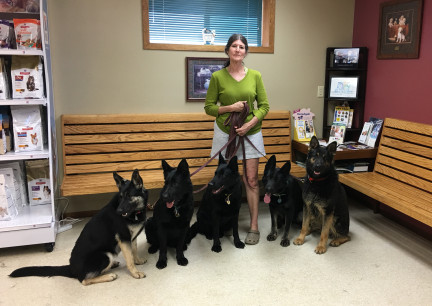
I can not stress enough that German Shepherd Dogs (GSD or GSDs) NEED, MUST HAVE, Basic Obedience for every day life. The GSD breed are large powerful dogs. They can easily hurt someone, unintentionally, knock down someone, even with just a friendly "jumping up on" someone. GSD's also need to know how to walk politely on leash without the constant pulling. That constant pulling, with a dog on one end of a leash and a human on the other is not good for the dog's esophagus, wind pipe, or the person's shoulder socket.
German Shepherd Dogs (GSD or GSDs) would make a wonderful choice for someone that would like to Show their dog in the Obedience Ring. GSDs are intelligent and love a job. When taught/trained correctly, a GSD could be handled by a child, making the GSD a good 4H Project Dog too.
I could go on and on and on about how to train your dog to be Obedient. But there are many books with photos written by people that show their dogs in the Obedience Ring. Or you can also look on line and find all sorts of information.
Better yet. Sign up for an Obedience Class in your area. Not only will YOU learn a lot, so will your dog. And to make it even more fun, you will meet other people training their dogs too. You might make a life long friend or even meet your spouse there....you just never know. But for sure! You and your dog will benefit from a local Basic Obedience Class.
One more note.....please work with your do each and every day. 15 minutes out of your everyday life is not too much to ask for you to spend with your dog training it. You will be happier with your dog, and the bond between you will be tighter too.
Basic Obedience Training is also the Gateway to everyday MANNERS your dog must learn to live well in your home. Learning to learn to behave, learning to learn the words "Sit" and "Down" and "Off", are very important for a Housedog or pet or working dog to know. Basic Obedience is also the Gateway for all other Dog Sports. If a dog does not know Basic Obedience, it will not be able to participate in Competitions.
Photo taken 2018-06-06 of a Vet Visit. Marna with (left to right) Teanna, Turquoise, Texas Tea, Tabaliah, Tychicus.
WORDING WHEN WORKING WITH DOGS ~ PLEASE NOTE!
One thing I do want to cover here is wording when used for Dog Training. Dogs do learn Human Words. But as Trainers of our Dogs, we need to make sure we are not only consistent, but also clear on what each word means.
This one, the word "Down", is my 'pet peeve' with pet owners. The command "Down" is used for a dog to lay down. It is not the word for them to not jump on people. It is not used for a dog to get off your couch. "Down" means for a dog to lay down. I get so frustrated with people that teach a dog "down" then when it is on the couch they use the same word....and get mad at the dog for just laying there.....THAT IS WHAT "DOWN" MEANS! TO JUST LAY THERE. Worse, this same person says "Stupid dog."
It is not just the "down" command that people misuse. Learn to teach your dog correct commands. Be consistent with using the same words for the same commands you have taught the dog. Learn that "Down" means to lay down. "Off" means to get off of something, be it the couch, or front feet from a person on the kitchen counter. First the person/owner/trainer needs to learn the commands, then they can teach their dogs properly.
"Here" and "Come" do NOT mean the same thing. "Here" means to come to you. "Come means to come to you, right in front of you, the closer to 'toe to toe' the better, and within the "Come" and the toe to toe, is also that the dog should automatically sit in front of you.
"Stay" and "Wait". Again. Basically the same, but different. "Stay" means to STAY, not to move. Even if the person with the dog moves, the dog does not. "Wait" can mean the same at your side, that is, to not move. But "Wait" is a command used with the dog, or at the door, it is more of a "just a moment" command rather than a 'plant it', command.
Keep in mind when naming your Dog, what that name might sound like to that dog....like naming a dog, 'Snow', this name sounds too much like "No.", to a dog. The dog might become confused, are you calling it or scolding it??
That Word/Task That No One Else Knows
It is good idea to have a Task/Trick that your dog does that no one else knows about. This way, if you did ever need to prove that your dog is YOUR dog, you would have that to 'fall back on'.
Very Basic Dog Obedience
Every single dog should at least know enough basic obedience that it has every day manners. Some will need to go to a class, some can be trained at home, some, well? May need to go to be trained by a Professional Trainer.
In my opinion, every dog needs to know how to "Sit", walk nice on a leash, "Down", "Off", "Stay", as well as "Go To Bed (or your room, or your crate, or whatever you want to call it)". Most importantly your dog needs to COME WHEN CALLED.
Your dog should know what the word "No" means and obey it. Teaching your dog "No" could save its' life. No means NO!, and the dogs should stop whatever it is doing when it hears you say it.
Before you start training your dog be in the mood to train. Don't train angry or drunk or sad or when you really want to be doing something else, it is just not fair to the dog.
Be consistent in how your train and how often you train. Training once in a while, usually on a rainy day, because the dog jumped on your with muddy feet is not fair to the dog.
Train daily at least once a day for approx 15 minutes. 15 minutes in 24 hours is just not that much to ask for a well trained dog. Once the dog gets going and begins to learn and enjoy your company, you and your dog will form a great bond and your will look forward to each training section.
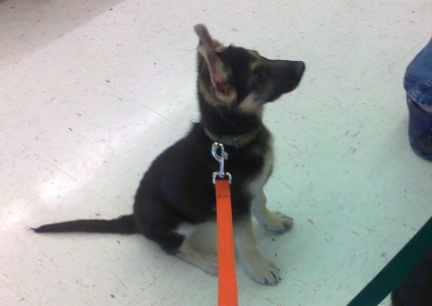
SIT:
We teach our dogs to sit as soon as they are weaned. Yes. Puppies can and do learn to sit. Puppies need to learn to learn, and for a little (break if down to a small bite) your puppy will learn this quick.....if you work with it.
To teach your dog to sit, yes even a new puppy, have a treat in your hand and hold it just above the dogs head, moving the treat in your hand slowly (very slowly) backwards, as you say "ssssiiiiiiiiit" (all drawn out) and, if needed, gently push your dogs butt to the floor. As soon as it happens (the dog sits) praise the dog verbally and give the treat. You might be very surprised how quickly your dog learns and reacts to the command "sit".
Photo of Titus von Kazmaier a couple of weeks after we brought him home.
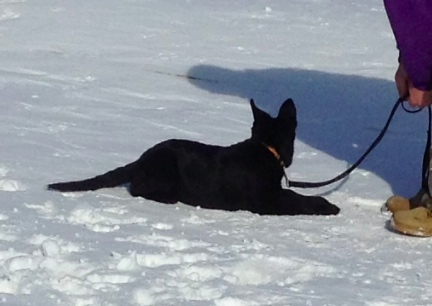
DOWN:
In my opinion a dog needs to know the "Sit" and be consistent at it before starting your dog on the "Down".
This usually goes well and pretty fast if the dog has already learned to "Sit".
Put your dog into a "Sit" as you stand or kneel in front of the dog. Using a treat, moving it between the dogs front feet and pulling it forward as the dog moves to get the treat as you say the word "Dooooooowwwwwn" again, draw the word out.
Praise the dog, give the treat and have the dog do something else. In a few minutes repeat the "Down" command.
If you dog is not going down with just the treat, most will however, then you will need to do one or more of the following....
...Hold the dog's collar, under the dog's chin, and gently pull as you show the dog the treat.
...Gently push down on the dog's shoulders and encourage the dog to go down.
...Gently grasp the dogs front legs and pull forward to encourage the dog to go into the down. This might scare some dogs, be gentle and remember to calmly say "Dooooowwwwn".
Note: Dominate dogs will be harder to teach the "Down" the submissive dogs. If you have been working with your dog for a while and have mixed in trick training and are a fair and just trainer, even the most dominate dogs will be happy to learn yet another command that will please you and get them a treat.
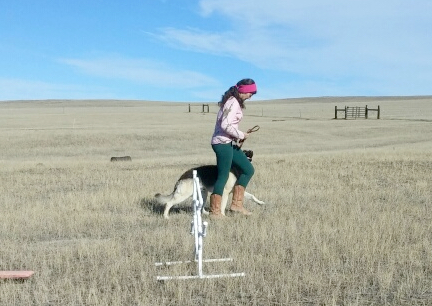
HEEL:
You can start your dog on heeling with a buckle collar, gentle leader (dog halter) or training collar. If however you do not know how to use a training collar don't use them, they can really hurt a dog and do permanent damage. Most dogs can and do learn to heel with little correction. If you have treats and patients HEEL training will go well for you and your dog.
I, personally, do NOT teach my dogs to "Heel" any too young. I like them to learn to pull confidently at the end of the leash. I like for them to lean the Sled Dog commands for Right, Left, Stop <Whoa>, On By and such, before I teach them not to pull on the end of the leash.....but that is because they are then learning to be a Sled Dog, the basics, at the end of a leash. Heel training comes later, all the rest of the Basic Obedience is learned, at our house, the minute we wean or purchase a new puppy.
If you are going to teach "Heel" at least be consistent with where the dog should walk as it "Heels" beside you. Dogs are waaaay more intelligent than the average person gives them credit for....many are more intelligent than the average human. If you are consistent, even consistently wrong, that is what the dog will learn from you.
LET ME STOP HERE AND TELL YOU THAT A DOG SHOULD NEVER HAVE TO ALWAYS WALK WITH YOU IN A HEEL. THERE IS ALSO THE LOOSE LEAD TRAINING THAT EVERY DOG SHOULD KNOW. LOOSE LEAD IS HOW YOU SHOULD WALK YOUR DOG WHEN JUST OUT FOR A STROLL. DOGS ON HEEL ARE WORKING, PAYING ATTENTION TO YOU, THEY ARE NOT OUT TO GO POTTY OR FOR REAL EXCERSIZE. LOOSE LEAD TRAINING IS WHEN YOUR DOG KEEPS THE LEASH LOOSE BETWEEN YOU AND IT, BUT IS NOT COMMANDED TO WALK IN A CERTAIN PLACEMENT AS IT GOES ALONG.
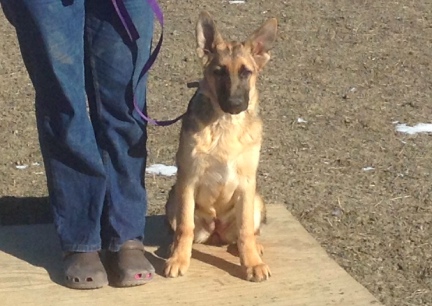
SIT AT HEEL:
Your dog will do better at this if it already knows how to "Sit" on command.
As soon as you start having your dog heel on command, walk at your heel (it's head parallel to your left leg) when you stop walking teach your dog to sit. Stopping with your left leg moving last (last step left leg) will also cue the dog.
The dog's sit should come straight away when you stop. The dog should sit straight.
Your dog will catch on to this so quickly. As you walk and your dog is at heel, first when training, slow down as a cue for the dog. Stop, as you stop say "Sit" and gently pull up on the collar and if needed gently push the dog's butt down. Make sure the dog is sitting straight (facing the same way you are).
The dog should sit each and every time you stop. You will not have to verbally tell the dog but a few times if you use the leash for a cue as you stop. When you stop move your hand with the leash in it upwards at first with a gentle pull to the dog, later just the cue will do it and soon, just your stopping will cue the dog.
However, Your dog does not have to know "Heel" to learn to "Sit at Heel". Sitting at Heel is a good thing to teach your young puppies as you have them out walking on leash. This will keep them safe and make them pay attention to you as they walk on leashes.
Photo is of Tekoa von Kazmaier. She had turned 4 months old 4 days before this photo was taken.....however, she has been Sitting at Heel for several weeks before the photo.
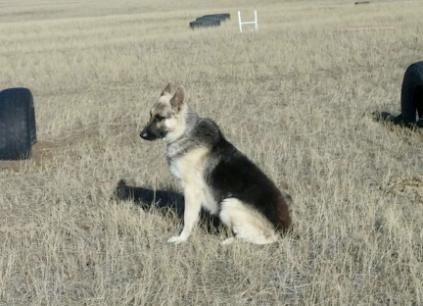
SIT STAY:
Do not start training the SIT STAY until the dog is consistent on sitting on command as well as sitting each and every time you stop as the dog is heeling.
After you stop while heeling. Step in front of and facing your dog. Make sure you step off with your right foot. As you take the step put your hand directly in front of the dogs nose and stay "Stay". Hold your leash above the dog and ready to make a correction if the dog moves. (most will not if you move correct)
Stand in front of your dog, but do not make eye contact, for a few seconds then step back next to the dog into the heeling position and praise the dog with both a treat and verbally.
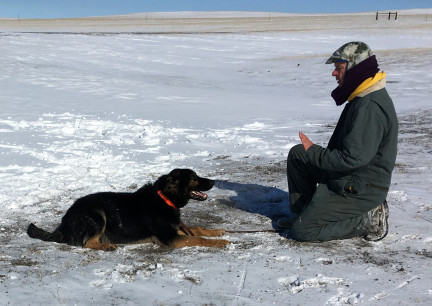
DOWN STAY:
Do not start the DOWN STAY until your dog is very consistent on the Down command. Your dog also needs to be very consistent on at least a one full minute "Sit Stay", if not the three minute "Sit Stay", before starting the "Down Stay". After your dog knows both the "Down" and the "Sit Stay", "Sown Stay" should come easy to your dog to learn. The dog should understand what you are asking....however, some might not. So start the "Down Stay" from the beginning, just as you taught the "Sit Stay".
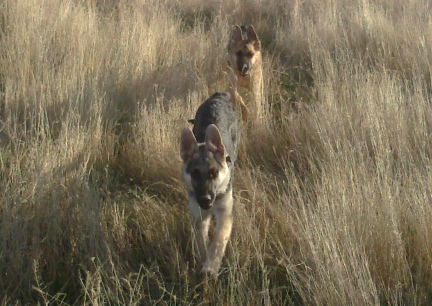
COME WHEN CALLED:
Now mind you. *The* COME is different then coming to you when you call the dog out of the yard or to dinner or the like. This, the coming when called as soon as the dog hears it's name, should be taught right away to a new dog or puppy. This is taught by calling the dog to you from short distances first, make a fuss over the dog, petting and praising it. Mix in a few treats now and again (but not every time) and your dog will be HAPPY to come to you when you "beckon" it.
If your dog is not coming to you when called: To teach a dog to come to it's name and to come when you whistle for it or to come when you say HERE, start right away, with this training, as soon as you bring your dog home. Put the dog on a leash and gently reeling it in giving it a treat as soon as it reaches you. Be sure to call the dog's name with a cue, such as the word "Here" or a whistle, or other key word, when you feed the dog. I use the word "Here" with my dogs when I want the near me when we walk, I am horseback riding and they are with us, or when we are out shed hunting. I use a whistle, using only my mouth, (the same whistle each time, I have other whistles for other commands for my dogs) for when I want them to come to me while on a walk (we live on 161 acres), to come into the house, to come and eat.
Training for "the" Obedience ring COME is taught after the dog is really sound (does it well) the Sit Stay. And normally, this dog also comes to you when you call it's name.
"The Come" is when your dog is called to you from a "sit stay" or a "down stay" and is usually done from 25' or more. The dog comes, after hearing their name along with the word "come", and it is only said once, it comes to you quickly, then "sits" right in front of your face to face. Usually but not always are the dog's toes just barely touching the owner/handler's toes.
Training "The Come" will be done on leash. You will need your short leash and later a rope with a snap on the dog end that is about 25' long for best results. Put your dog on a "Sit Stay" and go to the end of your 6' leash; remember, this is Advanced Basic Obedience and is only taught after your dog knows it's name well, and knows and does a "Long Sit Stay".
When you are ready to call your dog for "The Come"....look at the dog, make eye contact, call the dog's name, say "Come" and then give a slight tug on the leash, move the dog without words, to right in front of you and tell the dog to sit. Some dog's will get this command right away, many won't. Some will want to jump on you when they arrive to you, don't let them. Keep working at this until you can "Sit Stay" your dog, walk off, and Call the dog for a "Come", and it is running to you and what is called "Sitting Front".
The Come is the reason you should not teach your dog the word "Come" until you are ready to teach this behavior. Use a word like "Here", or "To Me", anything but a true "the" Come command.
BACK UP
This is simple to teach but might take much repetition with some dogs.
The easiest was I know to teach this is to sit your dog in front of you, facing you. The best place to do this is against a hall wall, or hallway, so that the dog will be backing parallel to the wall.
Have the dog on leash and say "Back Up" as you take a small step toward the dog. As the dog moves you may need to help keep it's butt straight. At first just hold the leash just above the dogs head so that it can not move to the side, just backwards.
As soon as the dog moves even the smallest bit backwards, praise and reward. repeat this training for three or four times then work on something different, like a trick, then come back to back up training. Don't bore the dog with too many repetitions in on section.
Most dogs catch on the Back Up pretty quickly.
Now if you have taught your dog the Swing to Heel in basic obedience it may take a bit more to teach this command. You may need to put your foot out to the dogs side so that it can only move backwards, not jump to your side.
MOVE or EXCUSE ME
This is a command that every dog must know. It is so important for a house dog to move when told for not only the humans in the house safety, but also the dogs safety.
To train this command, wait til your dog is all comfy on the floor, now walk over, right toward the dog and tell it the command you are going to use. I use "Move" because usually I am in a hurry when this command is necessary and the work "Move" has a harder sounding to it so most dogs will obey quicker with this word.
As you walk toward the dog and give the command, only a deaf or stupid dog would just stay in the way of your feet. But if your dog does not move, gently, and I stress gently, touch your dogs side with your foot as you continue to walk toward the dog....not be ready. If you startle the dog, and you might the first couple of times, be ready to catch your balance.
When the dog moves praise the dog verbally. Repeat throughout the day but do not over do it.
The idea is to give the command as you approach the dog and the dog will step out of your way. This way if you are carrying something, or just so that the dog does not trip you, the dog will move and give you the right away. It is also just a good command to remind the dog who owns the house.
WHAT'S THAT? or GO SEE!
When I was in Jr. High School I had a friend that owned a lovely Irish Setter, smart dog, well trained dog, very hyper. But no matter what was going on in the home they could say to that dog "What's That?" and the dog would stop dead in it's tacks and listen with ears perked. I thought that was really KOOOOL.
How do you teach your dog to do that? Well, there are many ways. I have taught it like this...
Have someone stand outside your door and just after you ask the dog, "What's that?" speak in a half whisper and quick tone. Have the outdoor person scratch the door. If the dog does not "get it", have the outdoor person knock lightly. The dog should go to the door and bark. Have the person that is outdoors to move to windows and around to the side of the house at different times making noises for the dog to listen for. As the dog catches on make the noise less and less loud.
Usually that is all it takes for the dog to catch on quickly to this command. Practice it two or three times a day.
Reward the dog less and less with food and reward with verbal praise.
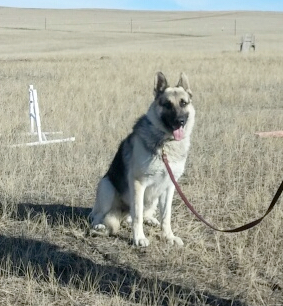
QUIET
Teaching, "Quiet" to a GSD is not only important, it also establishes Dominance. Dogs understand that someone is the 'Leader of the Pack', and YOU should understand this too.
If you let your dog bark at will, if you do not correct the barking at every noise, your dog will be under the understand that IT is in charge, the leader. More than that. If you verbally correct your dog from barking and the dog continues, and you do not follow through to make the dog stop barking when told, the dog will certainly see it's self as the Leader of the Pack.
If you correct your puppy/dog from barking at small things, and it continues to bark, or starts again after you turn around, you will need to walk over to the dog and correct it. SPANKING IT? NO! But if you do need more than words and walking over to the dog and putting it into a 'sit', you many well need to hold the dog's mouth shut for a moment, just enough to let the dog know you mean what you are saying. You do NOT need to hold tight, no cutting off breath. But you will need a hand on the collar too so that the dog can not back away and continue to bark.
If your dog continues to bark when told "Quiet", make your voice more of a low growl, a note your dog might understand better. Also, "Quiet!" is a COMMAND, not a Cue or an option.
One of the best ways to teach "Quiet" is to fist teach "Speak". This way you can treat for each. For a beginner dog owner or trainer THIS is the best way to teach, "Quiet".
Keep in mind. YOU might not mind your dog barking, but your neighbors will. If they call the Police, you will now be on record. Also. Teaching you dog NOT to bark at everything normal, will CUE YOU when the dog barks at what needs to be barked at.
LEAVE IT
A great command for the dog that like to get into things inside and out.
When a dog is chasing a cat, getting in the trash, digging in the garden, or the like it needs to quit when it is told to. "Leave It" is just that command. It is taught pretty much the way on by is, but may need a gentle jerk to the collar, or what is called a POP on a chock collar.
When taught right on leash, the dog will carry over the behavior when off leash and from other rooms in the house or several yards out chasing or other misbehavior.
You will need to set the dog up to win or fail as you will. If you dog likes to get into your trash, put some meat into the trash and the dog on a leash and sit close to the trash hoping that in a few minutes the dog will forget it is on leash.
As the dog moves toward the misbehavior, pull the dog back and say. in a firm voice "Leave It". Praise the dog for moving away from the scene of the crime and find another behavior to break.
Perhaps barking at another dog on a walk, or chasing a cat, acting like a fool when the mailman comes, what ever your dogs "weakness" is, work on that.
This command is pretty easy for the things your dog doesn't care that much about. But if you have a hard core mailman hater, it's ganna take some work....and yes, it is worth it to continue to train.
DROP IT!
Your dog comes to the door carrying a bone, or trash or a dead animal. Your dog needs to know the Drop It! Command. To teach "Drop It!" you need to start early. Say the command and reach in and take what the dog has. If the dog growls at you, roll them over in a submissive position and take the item from their mouth. Do not let the dog "win", that is, keep the item. You can also teach this to your dog during play with a ball or dog toy. Just give the command, and reach in and take the item. The dog will learn to drop the item upon the command if you are consistent with training.
By teaching this command you could save your dogs life. Not only could the dog have something it should not, like nasty things like dead squirrels, it could have something laced with poison.
EVERY DOG SHOULD KNOW AND OBEY THIS COMMAND!
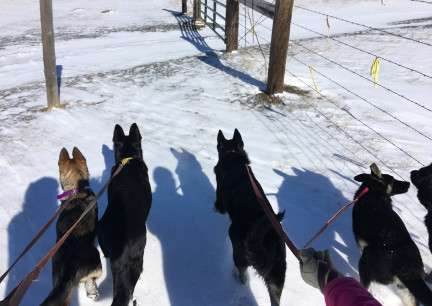
ON BY
This is actually a sled dog command. A wonderful command that means "keep going". Keep going and don't sniff the trash, don't look at that other dog, don't stop to pee, don't pick up that trash as you pass it, don't turn, don't stop, just keep going "On By".
On By needs to be taught on leash and distractions need to be added as your dog learns this command.
Take your dog out for a walk and set it up. Pass things your dog will want to pee on, to sniff, to bark at. Walk the dog in either a heel or just for a walk, when the dog stops, or turns or starts to do anything other then continue to walk forward, give the dog a gentle tug and say "On By" in a commanding voice. Go a few feet, turn around and walk by the same distraction again.
Like heeling, most dogs catch on to this command rather quickly....and it may save their life.
Deron and I often take our dogs, on leash for training, for a Morning Walk. We could not do this is they did not know 'On By', "Leave It', and a few more commands.
BACK OFF or ENOUGH
Ever go to visit someone and their dog went nuts at the door when you came. The owners reassured you that the dog is/was friendly and to come on in. You go in and the dog is growling, and watching and ruining the visit?
Many people want the visitor to pet and make a fuss over such an unruly dog. Or give it a treat. You know what that does? Encourages the dog to treat each and every visitor that way. And who wants to take a chance on a dog that acts this way...life is too short and bites hurt.
It is not funny, cute or exceptable when your dog does this. Your dog needs to be taught to BACK OFF or ENOUGH. When you say these words it needs to be over and the dog needs to go lay down or into another room.
If your dog is a puppy and if the behavior begins, stop it right away. Tell the dog to either BACK OFF or ENOUGH and put the dog into a down stay across the room. For an older dog you may need a leash on the dog. (read "Leave It" above for more hints for training).
STOP!
This is not asking. This is out and out Telling the dog to Stop whatever it is doing. When you start teaching this command, "Stop!", you need to mean it. You need to follow through. I promise you. When taught correctly, you will be so glad that your dog listens to you.
This command, I say again, is meant for ANYTHING! Whatever action the dog is doing at the time.
VERBAL GAIT CUES
Yes. You can, just like Equine, teach your dog Verbal Cues for the Gait you want them in. That is teach them to "Walk", "Trot", "Flying Trot", "Run" and "Faster". This is NOT hard to teach. Just give the command as you have them on leash at your side, and go the speed you are looking for. Don't over talk. Just give the Command, get to the speed, and say, "Good Dog".
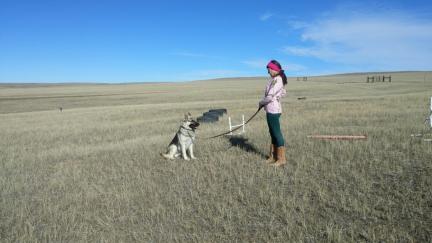
Mix in a little fun while training your dog Basic Obedience. Train a few tricks to your dog once he starts learning. Dogs love to please their owners and see them smile, doing tricks will make you both happy.
There is much more I could write on this page about training dogs. Training your dog, or keeping your dog on it's toes with the training you have in your dog, is non ending. All of the dog's life it should be expected to act in a way that is exceptable. Your dog should be polite around other people and other dogs. I will recommend strongly that you buy a book on Dog Training and have a little fun training your dog.
If you and your dog find that your LOVE Dog Obedience you may be interested in Earning Titles or Rally-O and or other Dog Sports.
**********
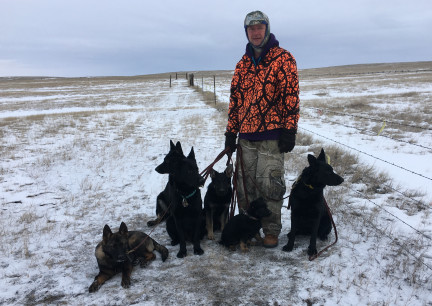 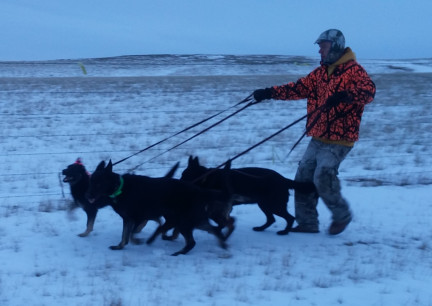
DERON AND I OFTEN TAKE OUR DOGS FOR MORNING WALKS HERE, ON LEASH, FOR TRAINING AND EXERCISE
The dogs have a 'place' in the line up and they are to stay in it. It gives them more of a 'meaning' or feeling of working, and it seems more like a 'thing' to them if they are expected to do something as they go.....like "EASY!" (not pulling on us, but keeping the leash tight), "Line Tight" to not have slacking (but not pulling) that someone could trip on or tangle in, and "Your Side", placement if they get out of line. "On By", don't stop, don't go left or right, and DON'T pick up the horse poop!. "Drop It", you can guess what 'it' it. "Whoa".....stop and stand right there....usually when one stops to potty the others are to stand in line and wait. "Haw" left turns....and "Gee" right, but we go around to the left. "STOP!", they know to stop whatever bad behavior they are 'performing' at the time. <laughs> And. When we get back, after Deron and I get leashes put away and coats off, they are suppose to keep sitting and wait for this, they get a big cookie and a 'good dog' (large milk bone type treat).....they love it!
TRAINING COLLARS
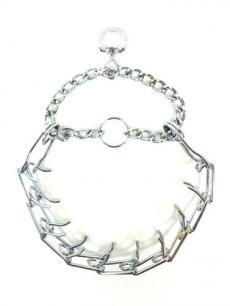
WE use Metal Training Collars. Both Choke and Pinch.
I like Metal because when you put it on the dog.....they know, without a doubt, it is 'work' time, by the feel of the collar, NOT the YANK of it. Metal can also send a powerful message if needed with an aggressive/spoiled dog.
Using the Training Collars correctly is WHAT most Obedience Classes are about....Training the Owner. <smiles and winks> You do not yank a Training Collar.
Metal is also good because the dogs KNOW that they are not being hurt, or harmed, or unloved. The NECK is where dogs correct, starting with their mothers, one another. The Pinch Collar is said to be less intrusive to tissues than the Choke. It also simulates another dog's teeth, cuing the wearer that a correction is being made and the wearer should "take heed". Puppies learn VERY early from those teeth on neck times, that when their mother's correct them, STOP THAT BEHAVIOR, AND NOT JUST FOR TODAY.
Dog's also use the Neck Holds on one another for Dominance. The owner's SHOULD show dominance over them. THIS is what a dog understands in their hierarchy.....or Pecking Order.
NEVER USE A TRAINING COLLAR ON A DOG LESS THAN 6 MONTH OLD.
DO NOT USE A TRAINING COLLAR UNLESS YOU KNOW EXACTLY HOW THEY WORK!
I would like to invite you to join us on a Yahoo Group that I host called Working Big Dogs. -- The Working German Shepherd Dogs Team
Tue, 30 Jul 2013 13:41:13 -0400
| 


 In the high plains of South Dakota, USA
In the high plains of South Dakota, USA In the high plains of South Dakota, USA
In the high plains of South Dakota, USA